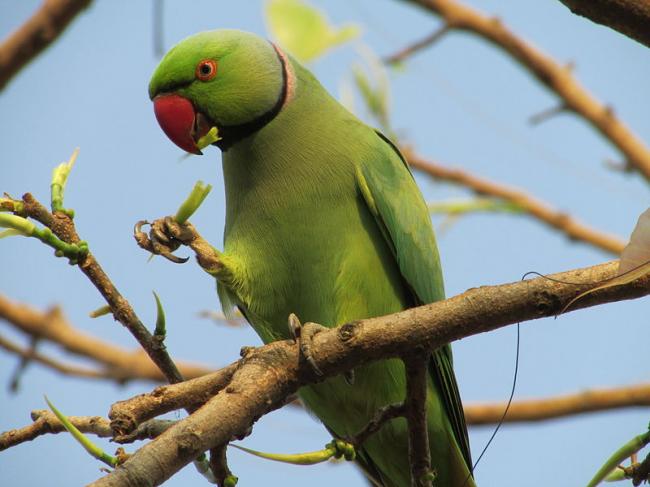
Birds learn from each other’s ‘disgust’, enabling insects to evolve bright colours, finds study
London, Dec 19 (IBNS): A new study of TV-watching great tits reveals how they learn through observation. Social interactions within a predator species can have “evolutionary consequences” for potential prey – such as the conspicuous warning colours of insects like ladybirds.
Many animals have evolved to stand out. Bright colours may be easy to spot, but they warn predators off by signalling toxicity or foul taste.
Yet if every individual predator has to eat colourful prey to learn this unappetising lesson, it’s a puzzle how conspicuous colours had the chance to evolve as a defensive strategy.
Now, a new study using the great tit species as a “model predator” has shown that if one bird observes another being repulsed by a new type of prey, then both birds learn the lesson to stay away.
By filming a great tit having a terrible dining experience with conspicuous prey, then showing it on a television to other tits before tracking their meal selection, researchers found that birds acquired a better idea of which prey to avoid: those that stand out.
The team behind the study, published in the journal Nature Ecology & Evolution, say the ability of great tits to learn what to avoid through observing others is an example of “social transmission” of information.
The scientists scaled up data from their experiments through mathematical modelling to reveal a tipping point: where social transmission has occurred sufficiently in a predator species for its potential prey to stand a better chance with bright colours over camouflage.
“Our study demonstrates that the social behaviour of predators needs to be considered to understand the evolution of their prey,” said lead author Dr Rose Thorogood, from the University of Cambridge’s Department of Zoology.
“Without social transmission taking place in predator species such as great tits, it becomes extremely difficult for conspicuously coloured prey to outlast and outcompete alternative prey, even if they are distasteful or toxic.
“There is mounting evidence that learning by observing others occurs throughout the animal kingdom. Species ranging from fruit flies to trout can learn about food using social transmission.
“We suspect our findings apply over a wide range of predators and prey. Social information may have evolutionary consequences right across ecological communities.”
Thorogood (also based at the Helsinki Institute of Life Science) and colleagues from the University of Jyväskylä and University of Zürich captured wild great tits in the Finnish winter. At Konnevesi Research Station, they trained the birds to open white paper packages with pieces of almond inside as artificial prey.
The birds were given access to aviaries covered in white paper dotted with small black crosses. These crosses were also marked on some of the paper packages: the camouflaged prey.
One bird was filmed unwrapping a package stamped with a square instead of a cross: the conspicuous prey. As such, its contents were unpalatable – an almond soaked with bitter-tasting fluid.
The bird’s reaction was played on a TV in front of some great tits but not others (a control group). When foraging in the cross-covered aviaries containing both cross and square packages, the birds exposed to the video were quicker to select their first item, and 32% less likely to choose the ‘conspicuous’ square prey.
“Just as we might learn to avoid certain foods by seeing a facial expression of disgust, observing another individual headshake and wipe its beak encouraged the great tits to avoid that type of prey,” said Thorogood.
“By modelling the social spread of information from our experimental data, we worked out that predator avoidance of more vividly conspicuous species would become enough for them to survive, spread, and evolve.”
Great tits – a close relation of North America’s chickadee – make a good study species as they are “generalist insectivores” that forage in flocks, and are known to spread other forms of information through observation.
Famously, species of tit learned how to pierce milk bottle lids and siphon the cream during the middle of last century – a phenomenon that spread rapidly through flocks across the UK.
Something great tits don’t eat, however, is a seven-spotted ladybird. “One of the most common ladybird species is bright red, and goes untouched by great tits. Other insects that are camouflaged, such as the brown larch ladybird or green winter moth caterpillar, are fed on by great tits and their young,” said Thorogood.
“The seven-spotted ladybird is so easy to see that if every predator had to eat one before they discovered its foul taste, it would have struggled to survive and reproduce.
“We think it may be the social information of their unpalatable nature spreading through predator species such as great tits that makes the paradox of conspicuous insects such as seven-spotted ladybirds possible.”
Support Our Journalism
We cannot do without you.. your contribution supports unbiased journalism
IBNS is not driven by any ism- not wokeism, not racism, not skewed secularism, not hyper right-wing or left liberal ideals, nor by any hardline religious beliefs or hyper nationalism. We want to serve you good old objective news, as they are. We do not judge or preach. We let people decide for themselves. We only try to present factual and well-sourced news.







